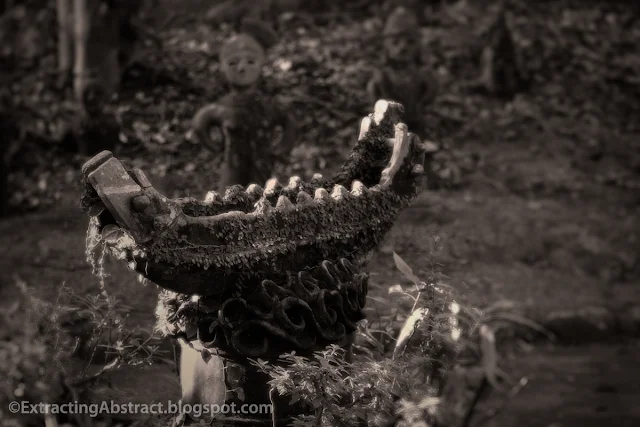Where does "Chestnut" come from then? Well, it is easier to guess than a tiger. It is due to the chestnut-like brownish color in the hindwings. In the forewings, the chestnut color is displaced by black distributing in streaks as well as the periphery of the forewing. In Japanese, it is called "Asagi madara (浅葱斑)". Asagi (浅葱) indicates faint (Asa/浅) indigo, whose color can be found in the translucent parts of their wings. Madara (斑) denotes "variegated", obviously it is due to the breathtaking circular patterns found at the bottom part of the wings. It is intriguing to note that the western common name came from brown pigments in the hindwing whereas the Japanese name is given by the "Asagi" color in the variegated patterns of translucent parts. Quite contrasting point of view!
Q: What is behind the beauty of butterfly wing colors?
A: The color is determined by the interaction between light and matter (See this for more in detail).
 |
| Schematic representation of blue color reflection |
Probably almost nobody can get this Q and A, just like "Koan" in Buddhist Zen school. Dark colors such as black, brown, red, orange, etc come from different types of pigments, such as melanin, Ommochrome, and Pterin (see this for more info) whereas particular colors such as blue appear as a consequence of a phenomenon called "wave interference" We as human recognize blue color in butterfly's wing because the corresponding parts reflect blue color (relatively shorter wavelengths around 470±25 nm) only but absorb the rest of visible spectra. Recognizing the white color on the object means all visible spectra are reflected and the black denotes all visible spectra are absorbed. The reflection of particular spectra is determined by the nature of nanostructures on the surface of the object. This is called "Structural coloration". It is, indeed, prevalent in nature (i.e. iridescent colors of the peacock's tail feathers) and the industrial domain (i.e. the surface of CD).


During evolution, mother nature evolved complex nanobiomolecule structures based on "chitin"- a long-chain polymer of N-acetylglucosamine, an amide derivative of glucose. It is a primary component of cell walls in fungi, whereas in insects, it is a building block constituting the exoskeletons of arthropods.
An additional reason why the butterfly is so colorful is the survival strategy. Similar to Homo sapiens, predators such as birds are inclined to avoid unnecessary colorful bugs as they tend to be poisonous. Chestnut tigers lay eggs on plants that belong to the Asclepiadoideae (Milkweeds), many of which accumulate poisonous alkaloid compounds. Chestnut tiger absorbs poisons only during the larval stage, yet, the poisonous molecules remain for the rest of their lives that are enough to cause predators horrible nausea and diarrhea when eaten.
Once in a lifetime long-distance migration
The Chestnut tiger is well-known for being a long-distance migrator that the ever-documented longest distance attained over 2500 km, followed by Monarch Butterfly (Danaus plexippus), the world's longest-distance migrator in the Lepidoptera family (= butterflies and moths).

Chestnut tigers are middle-sized (7-8 cm width) Asian butterflies distributed to Central-to-Eastern countries (Northern Pakistan, Kashmir, northern India, Sikkim, Tibet, China, Taiwan, Korea, Japan, Malaya, Ussuri, Sakhalin, Indochina). It is not clear why they don't settle in their birthplace, but instead, risk their lives by migrating long distances. You might think they are rich celebrities seeking a more pleasant environment to avoid sizzling summer and migrate up north or high latitude for their summer vacation and come back to their hometown in winter.
However, this is not the case. Their life span during the adult phase is less than 6 months!! Those who flew to the north in Spring end their lives in their summertime house and their offspring who hatched in the summer spontaneously move south as if they were taught where and how to fly (come back?) by their parents. Yet, the question still remains whether the offsprings always head for the parents' birthplace.
Settling and spending their whole life in their birthplace makes a lot of sense to me, rather than taking a risk of long-distance migration and flying across the sea in some cases. How low (or high) is the success rate of flying over 2500 km??? Is their reckless long journey driven by their instinct? Is this instinct barcoded in their genome???
The secret behind the long-distance migration of the Chestnut Tiger is the translucent parts (asagi color) of their wings.
Goodwyn et al., in 2009 reported that the translucent parts of their wings achieved to sustain two paradoxical and conflicting traits of (1) translucency and (2) superhydrophobicity. Rainfall during the flight is a fatal incident. They somewhat acquire accurate weather forecasts as well as superb rain jackets as if it is made of Gore-Tex fabrics!
Chestnut Tigers introduced in this entry were photographed in November at
Heiwadai Park (平和台公園) in Miyazaki Prefecture. The encounter with these stunning gems was just pure luck! I was not there to shoot them. They were taking a rest and charging energy there when I happened to be there.
Keeping my fingers crossed for a safe journey!


.jpeg)

















